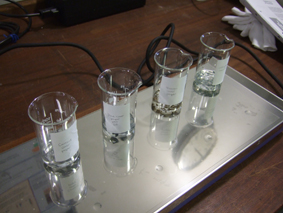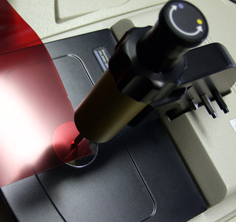Did you know there are beakers and high-tech equipment for scientific analysis here at The National Archives?
I know that the image of a scientific laboratory is quite at odds with the images that normally pop into your head when you hear the word ‘archive’, but all the same they are vital to the work that conservators undertake here every day.
Our conservation lab provides the facilities for us to evaluate materials for use in conservation, to prepare materials for use in conservation treatments and to carry out those conservation treatments that require the use of chemicals in a safe environment. To give you a little taste of the many things we do in the lab, here are a couple of examples of some of the material testing we’ve been up to lately:
Should we replace those old map folders?

Beakers of paper samples for pH testing
As part of making a case for a re-housing project, one of our conservators is pH testing both the existing map folder materials and the new material she suggests it is replaced with. This will enable her to quantify the benefits of the project. If the current material is significantly acidic, and the new material shows an alkaline buffer, it can help give a justification for her choices in the project.
What type of plastic is that again?
Plastic is a tricky material for conservation. Some of it is very useful in archival situations and most of it isn’t – with the potential for discolouration, distortion and leaching plasticiser staining or damaging anything it comes into contact with. Unfortunately, you can’t tell what type of plastic something is made of by just looking at it; you need to know its chemical make-up.

Close-up of FTIR-ATR
This is where FTIR-ATR (Fourier Transform InfraRed – Attenuated Total Reflectance) spectroscopy is useful for conservation – it allows us to compare spectra we take from samples in the collection or materials we want to use with a library of reference spectrum and hopefully come up with a match. This analytical technique is favoured by conservators because it is non-destructive and only leaves a faint mark on the material tested.
One of the things that we often use the FTIR-ATR to identify is photographic film. Over the years a number of different plastics have been used to make the base of photographic film negatives and while the date of the photograph can provide some indication as to what type of material the negative is likely to be made of, there are some time periods when material types overlap. The different plastics used in photographic film bases include cellulose nitrate, acetate and polyester. Polyester is a stable plastic, while both cellulose nitrate and acetate are unstable and have very specific degradation problems that are individual to each material. So it is important for conservators to be able to correctly identify photographic film negatives in order to be able to make choices impacting their preservation.
As you can see, working in the lab is all part of the decision making process for many of our projects here in the Collection Care Department and that science is an integral part of prolonging the life of our collection.